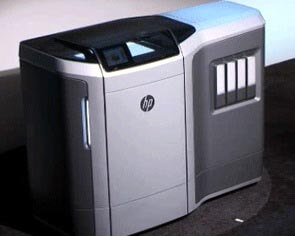Top 3D-Printer Brands Moving Away from Consumer 3D Printing

HP’s Multi Jet Fusion 3D printer for professional prototyping and manufacturing will be released later this year.
Last month, European IT market-research Context reported its sales-research data indicates that global 3D-printing market leaders Stratasys and 3D Systems are both beginning to refocus away from general consumer-level 3D-printers. The firm says this shift was foreshadowed by weaker consumer 3D-printer shipments in third-quarter 2015, and that it expects fourth-quarter 2015 results to be weaker as well.
According to Context, the Stratasys-owned MakerBot brand dropped to fourth place in terms of global market share during the third quarter, and 3D Systems, with its Cubify consumer brand (which it has since announced it will be dropping), fell to fifth. In 2014, these brands held the number-one and number-three spots.
Chart: Third-Quarter 2015 Global Desktop/Personal 3D Printer Unit Shipments and Share – Top 5
|
Rank |
Company | Brand |
Units |
Share |
|
1 |
XYZprinting | da Vinci |
9,050 |
18% |
|
2 |
Ultimaker | Ultimaker |
5,024 |
10% |
|
3 |
M3D | The Micro |
4,991 |
10% |
|
4 |
Stratasys | MakerBot |
4,144 |
8% |
|
5 |
3D Systems | Cubify |
4,040 |
8% |
Context however notes that not all brands have given up on selling 3D printers to general consumers for home use. It notes that at the recent Consumer Electronics Show (CES), XYZprinting, the new global leader in the desktop/personal 3D-printer segment, introduced its forthcoming da Vinci Mini 3D printer, which, priced at $269, is clearly aimed at the mainstream home market. Last year’s Kickstarter upstart M3D also recently reiterated its focus on general consumers with the promotion of its post-crowdsourced effort Retail Edition for $449, and its expansion into Amazon.com and Micro Center. Also announced at CES was the introduction of the very consumer-centric Polaroid 3D-printer brand into the European market in 2016.
According to Context, consumer curiosity for 3D printing remains, but there’s so far no killer app that makes a 3D printer a “must have” gadget.
While disillusioned, non-hobbyist home purchasers continue to find the technology “slow and complicated,” while educators recognize the longer-term implications of the growth in additive 3D-printing manufacturing, and continued to adopt the technology during 2015. Context expects this trend to continue in 2016 with more institutions from all levels of education purchasing desktop 3D printers, especially as the global focus on STEM (science, technology, engineering and math) subjects grows.
Context says that further validating education’s adoption of 3D printing is HP’s recent announcement of its Sprout Pro PC with built-in 3D scanning (for 3D printing), and which is primarily focused on education versus general computing.
More Resources
- March 2016: HP’s Dion Weisler Shares Thoughts on HP’s 3D-Printing Strategy; 3D Printers to Ship Later this Year
- January 2016: IDC: Global Spending on 3D Printing Will Grow at 27 Percent CAGR
- January 2016: IDC: China to Surpass U.S. with 3D-Printer Shipments this Year
- January 2016: 3D Systems Exits Consumer 3D-Printer Market; Expands Metal 3D-Printer Lineup
- December 2015: Global 3D-Printer Market has Hit Half-a-Million Shipments, but Market Struggling Lately
- November 2015: Toshiba Previews 3D-Printer Prototype that Can Fabricate Metal Objects
- November 2015: Epson Seeking to Have Faster, More Precise Volume Manufacturing 3D Printer on the Market in About Five Years
- October 2015: Ricoh Launches its First 3D Printer, the Ricoh AM S5500P, for Prototyping, Manufacturing
- October 2015: More on Canon’s 3D Printer: Faster Printing, More Precise and Durable Output
- October 2015: U.S. 3D-Printer Market is ‘White Hot,’ According to New Research from IDC
- September 2015: Gartner Forecasts that Almost Half-a-Million 3D Printers Will Ship in 2016
- July 2015: New HP Sprout 3D Scanner with Dremel 3D Printer Bundle is End-to-End 3D Design System

You must be logged in to post a comment.